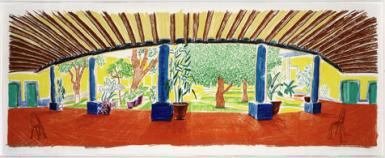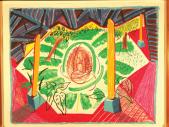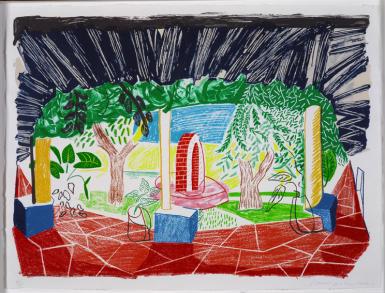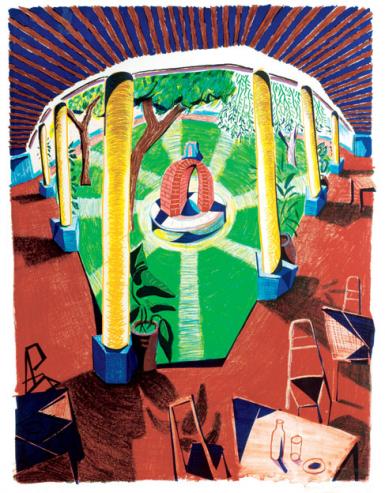





David Hockney | The Acatlan Story
Hockney’s impromptu stay at the Hotel Romano Angeles in Acatlan, Mexico in 1984 was the result of his car breaking down on the way to Mexico City for the opening of his exhibition ‘Hockney Paints the Stage’ at the Museo Rufio Tamayo.
Opting to stay at the hotel while his car was being fixed, he was inspired by the hotel courtyard and created the preliminary drawings and studies for a series of original drawings, lithographic prints, and finally an oil painting in 1984/85. The works produced dealt with space and perspective. The idea that a setting could be perceived in different ways, from both a physical perspective and emotionally by the viewer, was of particular interest to Hockney, both in these works as well as throughout his career.
Stating that the series was not ‘about a hotel’, Hockney delves into his surroundings, the result being a collection of intensely colourful panoramas transporting the viewer to the exotic Mexican hotel. This series alludes to the long hot days that Hockney spent painting in the Mexican sunlight, sat at his easel overlooking the lush greenery, a direct contrast to the warm red bricks of the well in the centre of the courtyard.
In order to create these lithographs Hockney made use of a new technique, the idea for which was developed by printer Kenneth Tyler (TGL). The method involved Hockney using rich inks to create sketches on transparent layers of plastic, known as Mylar sheets, using a different sheet for each colour. This allowed Hockney to layer the sheets upon one another this helped him to visualise the final outcome. The Mylar layering technique was of particular importance to Hockney and the portability of the plastic sheets allowed him to work outside and capture the true essence of his environment.
The final painting produced in 1985 was a diptych titled ‘A Walk Around the Hotel Courtyard’ painted in oil on canvas. The perspective used by Hockney in this painting is interesting, adopting a cubist technique where objectivity and convention are lost in the attempt to maximise space and colour, presenting the viewer with more visual information than would be observed in reality.





